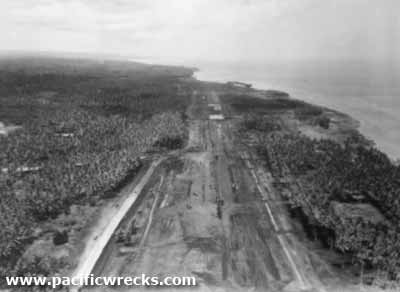|
|
|
|
| Missing In Action (MIA) | Prisoners Of War (POW) | Unexploded Ordnance (UXO) |
| Chronology | Locations | Aircraft | Ships | Submit Info | How You Can Help | Donate |
|
 US Army September 1944  Robert Laessig 1944 |
Location Wama Airfield was located near Gotalalamo (Bobaharam) on the southern coast of Morotai Island (Moratai) in the Maluku Islands (Moluccas Islands). Also known as Wama Field, Guama Airfield or simply Moratai (Morotai). Borders Pitoe Bay to the southwest and beyond the Gila Peninsula. To the north is the Doroeba Plain. To the northwest was Pitoe Airfield (Pitoe Crash Strip). After the U.S. landing, the U.S. Army built Pitoe Airfield (Pitoe) roughly 1,200 yards to the northeast. Prewar and during World War II located in the Netherlands East Indies (NEI). Today located in North Maluku Province (Provinsi Maluku Utara) in Indonesia. Construction After the U.S. Army landing on September 15, 1944 engineers found the Japanese built Pitoe Airfield unsuitable and surveyed the area for alternate locations. Over the next several days, this location surveyed and selected on September 18, 1944 as more suitable and Australians from No. 14 Airfield Construction Squadron arrived to help. On September 19, 1944 clearing began for a 5,000' runway parallel to the coast as the first Allied built airfiled on Morotai Island. Construction took longer than expected. By October 5, 1944 the engineers completed Wama Airfield with taxiways and revetments on the southern side of the runway. By October 17, 1944 they completed Pitu Airfield (Pitoe) with a connecting road. Wartime History When completed, it was the most forward Allied airfield in the South West Pacific Area and was used by the fighter planes from the U.S. Army Air Force (USAAF) Far East Air Force (FEAF) and Royal Australian Air Force (RAAF). Designated U.S. Army Post Office 719 (APO 719). Allied pilots remembered the base for its strong winds, which took their toll on aircraft that approached too slowly. Allied units based at Wama Airfield on Moratai U.S. Army Air Force (USAAF) 35th FG HQ arrives September 27, 1944 35th FG, 41st FS (P-47) Owi arrives October 17, 1944–January 21, 1945 departs Mangaldan 18th FG, 12th FS (P-38 detachment) Sansapor arrives November 8, 1944–January 10, 1945 departs Sansapor 4th PRG, 17th PRS (F-5) May 7, 1945 departs Puerto Princesa 347th FG, 67th FS (P-38) Middleburg arrives February 12, 1945–March 21, 1945 departs Puerto Princesa 71st TRS (detachment) Biak arrives October 1, 1944–December 31, 1944 departs San Jose 82nd TRS (detachment) Biak arrives October 1, 1944–December 31, 1944 departs San Jose Royal Australian Air Force (RAAF) No. 79 Squadron (Spitfire) 1945 No. 452 Squadron (Spitfire) arrives December 11, 1944–June 29, 1945 departs Tarakan No. 457 Squadron (Spitfire) arrives February 1945–June 19, 1945 departs Labuan Japanese air raids against Morotai The Japanese made a total of 82 air raids against the Morotai airfields between September 15, 1944 until February 1, 1945. reaching a peak in November 1944 with a raid every day. Tokyo radio dubbed Morotai the "graveyard of the 13th Air Force". In reality, most were only nuance raids, but some had disastrous effects. On November 22, 1944 before midnight ten Ki-21-II Sallys from 12th Sentai and 14th Sentai bombed Morotai and destroyed fifteen parked planes (including four A-20G Havocs from RAAF No. 22 Squadron) and damaged eight other, the most damaging air raid they experienced during the Pacific War. Dena "Thumper" Huitt, 41st FS adds: "We lost several planes by Japanese bombing raids at Morotai. There were only about two nights during November that we didn't have a red alert. Lots of foxhole time! One night a bomb landed in a foxhole in the enlisted men's are and killed four of our men." Richard Debaugh, 41st FS adds: "We took off many times configured with three external fuel tanks, a 150 gallon tank under each wing and a belly tank of 100 gallons." Robert Brewer, 41st FS adds: "There were times when we had 3 external tanks for a long mission when we used the bomber strip and used water injection to get airborne." Peter Flahavin adds: "My Dad was stationed there in Australian Army signals from March to September 1945 and vividly remembers all the air activity. To amuse themselves they used to cut up fighter belly tanks and turn them into fishing boats or yachts of the Morotai Yacht club. The Japanese were 25 miles away on Halmahera so you had to watch the currents." A6M5 Model 52 Zero Surrendered at the end of the war Postwar By the end of the Pacific War, many surplus Allied planes were abandoned on Morotai Island. By the late 1940s most were scrapped. Today Disused since the Pacific War. The former runway area is visible from the air with roads and taxiways. Robert Dunn visited in 1997: "I visited Moratai: Wama Strip and Pitue Strip. The locals showed us around we found a pile of Australian broken beer bottles next to Wama . The hot mix is still ok on Pitue." References U.S. Army in World War II The Approach to the Philippines Chapter XIX The Palaus and Morotai: Strategic and Tactical Planning pages 476 (map) U.S. Army in World War II The Approach to the Philippines Chapter XX The Morotai Operation pages 490, 491 Contribute
Information Last Updated
|
Photo Archive Map Sept 15, 1944 Map Fallingrain View in Google Earth |
| Discussion Forum | Daily Updates | Reviews | Museums | Interviews & Oral Histories |
|